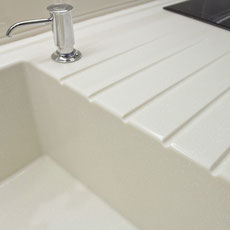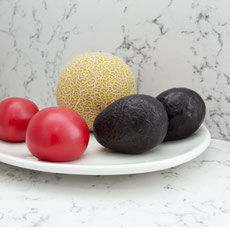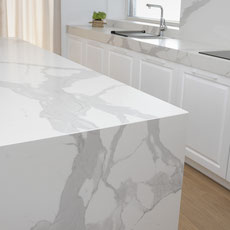ARTIFICIAL STONE - engineered surfaces
Artificial stone worktops, walls, floors, stairs closely resemble natural stone pieces. Engineered surfaces have similar textures and patterns to those of natural stone, but they are often regarded as more durable and easier to maintain than natural stone. Solid surface, engineered quartz, sintered stone and ceramic surfaces, all manufactured using advanced technologies, look modern and elegant in any architectural space.
What makes artificial stone materials special?
Engineered surfaces in private homes, hotels, restaurants, medical premises are valued for their hardness and considerable thinness. They are non-porous or very little porous. This latter characteristics means that spilled liquids do not penetrate into the countertop, making it easy to clean. Thus you can can keep your kitchen or bathroom surfaces tidy with smallest efforts. Non porous artificial stone surfaces do not need to be sealed. Moreover, acrylic solid surface slabs can be formed and folded during the manufacturing process. This makes it possible to fabricate sinks from the same material and integrate them into countertops without any visible seams.
Most artificial stone worktops are stronger and less fragile than those made from natural stone, such as marble, onyx or travertine. Engineered surfaces can resist stronger abrasion, scratching, UV rays. Acrylic solid surface is the softest and less scratch-resistant of the engineered materials, but the good news is that old or damaged acrylic furniture can be repaired and repolished as many times as necessary. Once repolished, old acrylic stone worktops will look new again, generally no signs of repair will be visible.
The standard thickness of artificial stone slabs is 12 mm or 20 mm. Thinner panels (6 mm and 3 mm) are commonly used for wall cladding and furniture facades. In comparison, natural stone slabs generally are 20 to 40 mm thick, therefore tend to be heavier and bulkier than engineered stone slabs. The lighter the slab, the easier it is to transport, work and install it. Thin worktops look modern, elegant and minimalistic. If needed, the edges can be broadened to the required thickness when manufacturing the worktop, but this does not result in a significantly heavier piece of furniture.
artificial stone fabricators in lithuania
ARTIFICIAL STONE TYPES
| ACRYLIC | QUARTZ | SINTERED | CERAMIC | |
| BRANDS |
Corian Staron Meganite Grandex |
Radianz Avant Silestone Caesarstone |
Neolith Dekton Lapitec
|
Laminam Emil Ariostea |
| WHAT IS IT? |
70% natural stone (grounded into powder) and 30% resins and pigments (measured by weight) |
95-97% natural stone (grounded into powder) and 3-5% resins and pigments (measured by weight) |
100% natural (earth minerals sintered into slabs by using very high temperature and extremely high pressure) | 100 % natural clays and other minerals |
| APPEARANCE |
Matte Polished Monochrome Patterned Relief |
Matte Polished Monochrome Patterned |
Matte Polished Monochrome Patterned Rough Wavy Relief |
Matte Polished Monochrome Patterned Rough Wavy Relief |
| HEAT RESISTANCE | Resistant to heat up to +100 °C, use trivets under hot pots and pans | Resistant to heat up to +150 °C, use trivets under hot pots and pans | Resistant to extreme heat, no need to use trivets under hot pots and pans | Resistant to heat |
| SCRATCH RESISTACE | Can scratch, scratches can be professionally refinished | Highly scratch resistant | Extremely scratch resistant | Highly scratch resistant |
| CLEANLINESS |
Non-porous Antibacterial Can be used commercially in food preparing and medical premises (most brands have NSF 51 rating) |
Non-porous Antibacterial Can be used commercially in food preparing and medical premises (most brands have NSF 51 rating) |
Non-porous Antibacterial Can be used commercially in food preparing and medical premises (most brands have NSF 51 rating) |
Non-porous Antibacterial Can be used commercially in food preparing and medical premises (most brands have NSF 51 rating) |
| FABRICATION | Seams and joints will typically be invisible, many edge options available | Seams are very tight, but visible, many edge options available | Seams are very tight, but visible | Seams are very tight, but visible |
| MAINTENANCE | No sealing necessary, repairable, top can be repolished to restore original finish | No sealing necessary | No sealing necessary | No sealing necessary |
ARTIFICIAL STONE PROPERTIES
| HEAT RESISTANT | WILL ETCH | WILL SCRATCH | WILL STAIN | CAN BACKLIGHT | |
| ACRYLIC STONE | x | x | |||
| ENGINEERED QUARTZ | (x) | ||||
| SINTERED STONE | x | ||||
| CERAMIC SURFACE | x |
Which type of artificial stone to choose?
Before choosing the artificial stone type for your project, first think about its overall purpose, the aesthetic qualities you expect from the product, and the time you want to dedicate to its maintenance. Knowing this will make it easier to decide whether acrylic, quartz, ceramic or sintered material is best for you.
If you are planning to install a new bathroom vanity with integrated sink, then acrylic solid surface, such as Corian, Meganite or Staron, might be the most logical choice. This is because solid surface fabricators can fold a sink out of the same material as the vanity surface, and join the two without any visible seams. You can also have a splashback attached to the vanity by slightly rounded angle (radius), so that all parts form a one-piece item.
Acrylic solid surface products don't just look one-piece. If profesionally fabricated, virtually no microscopic cavities are left along fabrication joints for water or dirt to accumulate. Acrylic solid surface slabs can be shaped and folded, therefore this material is particularly suitable for curvy reception desks and other non-standard furniture items. Solid surface is an excellent choice for artistic and unusual architectural projects.
If you are thinking of a kitchen countertop that would have a stunning look and require low maintenance, you might choose to have it fabricated from engineered quartz, such as Radianz or Avant. Quartz worktops are very durable, and they maintain their great look for the entire lifetime with just a little care. Engineered quartz has been very popular in Scandinavian kitchens for many years. Quartz is a good choice for dining tables, furniture tops (such as night stands or chest of drawers), windowsills, bars, reception desks.
Ceramic and porcelain surfaces, such as Ariostea or Laminam, have similar aesthetic properties to engineered quartz. These materials are very durable and practical, and at the same time have elegant and minimalistic look. Wide format porcelain slabs are increasingly used for producing kitchen worktops and bathroom vanity tops. Porcelain windowsills also look great. Lightweight and thin ceramic slabs (3-6 mm) can be used for furniture fronts, they suit well for cladding bathroom walls and fireplaces.
If you want to chop meat or set fire on your future worktop, then you should choose sintered stone for it, such as Neolith, Lapitec or Dekton. Thin sintered stone slabs are great for hot fireplace surrounds (ceramic also suits well for this purpose, quartz is less suitable, and acrylic stone is not suitable at all). As sintered stone is extremely durable and scratch resistant, it can be used in high traffic areas for stairs, floors and walls. Being non-porous and UV-resistant, sintered stone slabs are ideal for building facades. Sintered stone surfaces do not need to be sealed, no matter where they are placed and whatever their purpose. Rain, frost, and icing are no threat to them. Sintered stone items visually add a very modern look to the space.
In terms of average cost, engineered stone materials rank from the cheapest to the most expensive in the following order: acrylic - ceramic/porcelain - quartz - sintered. Each material has its own price categories, depending on the chosen pattern and design. The price spectrum also varies from one manufacturer to another. It is possible that a product chosen from the most expensive category of acrylic solid surface will be more expensive than the product from the cheapest category of quartz.
Comparison of engineered quartz to sintered stone
Engineered quartz and sintered stone are both very hard surfaces. They are non porous, scratch resistant, and do not stain easily. The main difference between these artificial materials is in their composition. Engineered quartz is a combination of natural mineral quartz particles (around 95-97%) and special resin binders with added pigments (3-5%). Percentage is generally measured by weight. Sintered stone is composed entirely of natural minerals that are transformed into a new material through the process of sintering. This process uses intense heat, intense pressure and electricity to transform the minerals into a solid hard mass of a new material.
Quartz and sintered stone are both very hard, even harder than granite. They are scratch resistant and very durable. Sintered stone is even harder than engineered quartz. Both quartz and sintered stone are non-porous. This means that their surface is not easily stained since liquids cannot penetrate inside the material to discolor it. Cleaning sintered stone and engineered quartz items is easy, as the stain-causing agents remain on top of the surfaces.
Because of their different composition, sintered stone and engineered quartz have different care requirements. Quartz surfaces can be susceptible to burning from very high temperatures. This can happen in the fabrication shop or at home. If engineered quartz is exposed to extreme heat, it can discolor because of resins in the material. Sintered stone is manufactured in extremely high temperatures, and is therefore resistant to any heat sources found in everyday household environments.
Comparison of sintered stone to ceramic
Sintered stone is manufactured from similar raw materials as ceramics, but there are two key differences: the additional components and the pressure applied. Sintered stone contains the raw materials used to manufacture quartz and glass, which makes sintered surfaces stronger and more durable than ceramics and porcelain. In addition, extreme pressure and temperature is used to compress and fuse the components together. The conditions in which sintered stone is manufactured resembles those deep inside the earth needed for rocks to be formed naturally. Today's high technologies simulate these processes and speed up the process. While it takes millions of years for the rock to form in the ground, modern technology reduces the time to one or two days.
Comparison of ceramic to porcelain
Ceramic and porcelain slabs are produced in a similar way, but the raw materials used differ. Porcelain is made from a special clay of very fine grain, whereas ceramics are made from other clays and may contain more constituent rocks. The differences are also influenced by the compression of the mixture in the press. Porcelain is more densely compressed than ceramics, which makes the porcelain slab harder and stronger. Porcelain sheets are slightly flexible and UV-resistant. Porcelain and ceramic countertops are resistant to chemicals, wear, cold. In addition, they are environmentally friendly and easy to recycle. Porcelain can also be referred to as ceramic, but not all kinds of ceramic is porcelain.







